
Trending Today

“Archetype” is a fancy word for recurring patterns, themes or styles. This article aims to provide some insight on the common styles of lists that you’ll run into playing Legion. If you’re a newer player, it will also help clarify some common jargon around list building. If you have some experience, I hope it inspires you to try something different than what you’re used to playing.
Lists in Legion have three main archetypes: Standard, MSU, and Skew. I’ll provide a definition of each of these terms and offer some example lists. I’ll delve into how these lists expect to gain an edge over the opposition. Archetypes are archetypes because they are proven list building techniques. I encourage you to take them and try them out yourself. They range in relative overall competitiveness, but I don’t know your local meta.
You’ll find that certain heroes plug into these archetypes more easily than others. Sometimes the hero you want to play has a high points cost and that pushes you to play a particular style. It can also work the other way: you are in love with a faction but aren’t tied down to playing any character in particular, but want to try a different type of list than the one you’ve been playing already.

Standard lists consist of a leading actor and supporting cast. You have a single expensive unit that’s the center of the list, the sun around which everyone else revolves. The rest of the list is dedicated to supporting the centerpiece and carrying out objectives. The centerpiece unit is very powerful stat-wise with unique abilities, and therefore very influential, causing large ‘swings,’ – events that tip the balance of the game in the opposite direction. Sometimes they simply carry the game by virtue of being who they are. Think of Sabine’s bombs and jumping ability, or Emperor Palpatine’s force lightning spam and Pulling the Strings – these abilities can easily turn a losing game around.
The main drawback is that you’re heavily invested in one unit. If they fail to perform, either by dying early (because you were too aggressive) or failing to do their job (out of position) you’re probably going to lose. Meanwhile, the points cost has lowered the relative quality of the units surrounding it. These lists most closely resemble the lists that were possible out of the core box and the first wave of expansions, and make up, by my estimation, roughly half of what’s currently played.
800/800 (11 activations)
Commanders:
– Rebel Officer = 50
Operatives:
– Luke Skywalker (200): Force Push (10), Force Reflexes (10), Jedi Mind Trick (5), Tenacity (4) = 229
– R2-D2 = 35
Corps:
– Rebel Troopers (40): SX-21 Trooper (20) = 60
– 2× Rebel Troopers (40): DLT-20A Trooper (26) = 132
Special Forces:
– 3× Strike Team (20): DH-447 Sniper (28) = 144
Supports:
– 2× AT-RT (55): Rotary Blaster (20) = 150
•You Serve Your Master Well, •Son of Skywalker, ••Full of Surprises, ••My Ally is the Force, •••Return of the Jedi, •••I am a Jedi, ••••Standing Orders
As you can see, this list revolves entirely around getting Luke into combat safely and supporting his push. A supporting gunline of rotaries, snipers and two DLT-20A troopers cover Luke’s approach from range and take care of objectives. The SX-21 squad follows Luke in, becoming a good target for his You Serve Your Master Well. R2-D2 provides an extra activation, an additional win condition, and can repair the rotary RTs. You’ll notice that Luke is 229 points, over a quarter of the list’s total points, and that everything else has had to become lower quality (with the exception of R2-D2.) The list also runs all six of Operative Luke’s command cards. We call this sort of list “800 points of Luke.”
800/800 (10 activations)
Commanders:
– General Veers (80): Electrobinoculars (8) = 88
Corps:
– Shoretroopers (52): T-21B Trooper (32), Comms Technician (10), HQ Uplink (10) = 104
– DF-90 Mortar Trooper (36): Comms Relay (5) = 41
– 2× Stormtroopers (44): RT-97C Stormtrooper (26) = 140
– Stormtroopers (44): DLT-19 Stormtrooper (24) = 68
Special Forces:
– 3× Strike Team (20): DLT-19x Sniper (28) = 144
Heavies:
– AT-ST (170): Elite Armor Pilot (10), Twin Light Blaster Cannon (20), Mortar Launcher (10), Linked Targeting Array (5) = 215
•Maximum Firepower, •Ambush, ••Pinned Down, ••Push, •••Imperial Discipline, •••Coordinated Fire, ••••Standing Orders
On the Imperial side, we have an AT-ST and its ecosystem – Veers and Comm Tech Shores. The ST is threatening at all ranges and influences the board very heavily – I jokingly refer to it as the “Eye of Sauron” since its height enables it to see just about everything. The Comms Tech Shores enable you put an order on the ST all six turns, ensuring that you maintain control over it, gain the aim from Linked Targeting Array, and generally maximize its effectiveness. Veers is in command and has heavy synergy with everything in the list, going first and keeping the army supplied with aim tokens, and recovering the HQ Uplink with Imperial Discipline. The other corps units and snipers do objectives and hold the line against the enemy, counterattacking things that threaten the AT-ST.
The opposite of Standard, where there is no single dominant unit. Points are distributed more evenly over more units, sacrificing quality for quantity. This results in a high activation count, but each unit is individually weak. However, if you lose a unit, it’s not so damaging since you have so many others. Lists like this rely on the whole being greater than the sum of its parts. This requires all elements of the list to engage simultaneously. If the army doesn’t engage all at once, the benefit of their massed firepower is lost.
An MSU list can contain chaff units with the sole task of thwarting enemy movement, and causing a significant investment of resources from your opponent to deal with them. Meanwhile, you’ve used your time to get a leg up on the objective game. B1 Battle Droids are the quintessential chaff unit, occupying the attention of units far more expensive than they are. Another good example are naked Imperial Royal Guards or Wookiee Warriors. These units have higher than normal health, are good in melee, and take some effort to dislodge once they get in. Tying things up in melee like this is a tactic called ‘tar pitting.’
800/800 (12 activations)
Commanders:
– General Veers (80): Aggressive Tactics (10) = 90
Corps:
– 2× Stormtroopers (44): HH-12 Stormtrooper (26), Stormtrooper Specialist (15) = 170
– 2× Stormtroopers (44): RT-97C Stormtrooper (26) = 140
– 2× Stormtroopers (44): DLT-19 Stormtrooper (24) = 136
Special Forces:
– 3× Strike Team (20): DLT-19x Sniper (28) = 144
Supports:
– 2× E-Web Team (55): Linked Targeting Array (5) = 120
•Ambush, •Maximum Firepower, ••Pinned Down, ••Push, •••Imperial Discipline, •••Coordinated Fire, ••••Standing Orders
During the first set of releases, I would call this kind of list “The White Wall” due to how tough it seemed to be to shift Stormtrooper spam with the units in the Rebel core set. This example goes back to a similar principle, but pushes for higher activation counts by taking snipers and E-webs. Veers is in his usual economizing role, this time with Aggressive Tactics to increase the defenses of all the troopers in addition to his usual role as Spotter. The “chaff” idea in this list is that it takes a fair amount of investment to remove anything that can surge on red defense dice (Pierce being the exception.) Snipers, rocket specialists and the Sentinel carrying E-webs with Pinned Down make this list extremely adaptable. All the members of this list are quite eligible to do objectives (you probably don’t want to play Recover, but you have some tools to prevent the middle from being grabbed if you must.)
800/800 (13 activations)
Commanders:
– Leia Organa (90): Strict Orders (5) = 95
Operatives:
– R2-D2 = 35
Corps:
– 4× Rebel Troopers (40): Z-6 Trooper (22) = 248
– Rebel Troopers (40): R5 Astromech Droid (8) = 48
Special Forces:
– 3× Strike Team (20): DH-447 Sniper (28) = 144
Supports:
– 2× AT-RT (55): Rotary Blaster (20) = 150
– Laser Cannon Team (70): HQ Uplink (10) = 80
•Coordinated Bombardment, •Blast Off!, ••No Time for Sorrows, ••Push, •••Covering Fire, •••Somebody Has to Save Our Skins, ••••Standing Orders
This list is really going for the “multiple” and “small” in MSU. None of the units are 100 points or greater. Most of the units are quite poor defensively, but there are just so many of them. The high activation count will cause enemies to expose themselves to more shooting on average (see the article on counting for more). Thirteen shooters also means this list will be good at generating suppression. The FD, snipers deal damage at long range, with a Z-6 blob and two rotary RT delivering the spike damage.
Skew lists are built around specific tactics or keywords. Often they are focused around a single unit or mechanic employed en masse. They are usually making aggressive, risky plays and going for a knockout punch. If they miss, they are generally in hot water afterward. These lists can be all kinds of zany fun. Sometimes these lists take concepts from the other two archetypes and turn them on their head – the chaff units become the focus. Skews ask your opponent a fundamental question: can you handle what I’m bringing?
Lists like these are… selectively dominant (read: inconsistent). The focus on a single tactic or set of units leads to being ruthlessly hunted by their natural predators. Skew lists are a gamble in a tournament environment, but are always exciting. Skews can go in any number of directions, but Armor is the most common skew of all since it’s such a strong keyword. Melee/close range, medic spam, you name it, you can probably come up with a skew around it.
800/800 (12 activations)
Commanders:
– Han Solo (120): Strict Orders (5), Environmental Gear (3) = 128
Operatives:
– R2-D2 = 35
Corps:
– 4× Rebel Troopers (40): Z-6 Trooper (22) = 248
Special Forces:
– 3× Strike Team (20): DH-447 Sniper (28) = 144
Supports:
– 2× AT-RT (55): Flamethrower (20), HQ Uplink (10) = 170
– AT-RT (55): Flamethrower (20) = 75
•Ambush, •Sorry About the Mess, ••Reckless Diversion, ••Turning the Tide, •••Change of Plans, •••Assault, ••••Standing Orders
This list is a modern spin on an old favorite, “Sorry About the Barbecue.” The whole thing revolves around the tactic of playing Han’s Sorry About the Mess command card while uplinking Flamer RTs. Flamer RT are devastating against the right targets, and they have the Armor keyword which negates all normal hit results, and you can bring three of them at a relatively cheap cost. All three RT engage at once and the Z-6 troopers and Han follow behind a wall of fire-spewing armor. Han’s Change of Plans and Reckless Diversion cards are set to disrupt your opponent and prevent them from destroying the flamer RTs before they get their damage in. The snipers take care of objectives and help finish off wounded enemies. As in previous lists, R2 repairs the RTs and provides an alternate win condition.
Side note: You’ll notice this list has a high activation count. This is because MSU lists are skews in and of themselves – skewing towards higher than normal activation counts to gain an edge.
800/800 (10 activations)
Commanders:
– General Veers = 80
Corps:
– 4× Stormtroopers (44) = 176
Special Forces:
– 3× Strike Team (20): DLT-19x Sniper (28) = 144
Heavies:
– 2× AT-ST (170): Elite Armor Pilot (10), Grenade Launcher (15), Linked Targeting Array (5) = 400
•Maximum Firepower, •Ambush, ••Evasive Maneuvers, ••Pinned Down, •••Imperial Discipline, •••Assault, ••••Standing Orders
A modern twist on a classic Imperial armor skew – Double AT-ST with a side of Linked Targeting Array and triple snipers. Notice that half the points are spent on the two AT-STs. Veers himself really leans into his role as a vehicle commander, spotting both of the AT-ST and supplying them with good commands, turning on their Linked Targeting Arrays. If anything can hide from both of the towering behemoths, the Grenade Launcher makes short work of their cover with the Blast keyword. There is also plenty of Impact between the AT-ST main guns and Veers’ Maximum Firepower.
Both this list and the previous list ask the opponent if they can handle 18+ wounds of high damage armor. What’s more, this list is somewhat of a counter to itself, since a single AT-ST is quite good at defeating enemy armor, and you have two of them. Your corps options are very limited, so you’ll need to protect them to make sure you can do objectives.
Copyright © 2024 The Fifth Trooper. All Rights Reserved.
4 Responses
Hi,
I have a question on how it would work with the comms technician shores putting an order on the AT-ST? I cant seem to figure out how that would work..
Hi Jordy,
It’s the relay on the mortar – the shores use uplink, coordinate to the mortar, which relays to the AT-ST. Unfortunately Comms Relay received an errata after this article was published and this no longer works.
thnx a lot! it makes much more sense now 😉
I’d like to ask about Agressive Tactics in the „White Wall” Imperial list. Without any source of additional order tokens except from Command Cards, is this card worth taking?